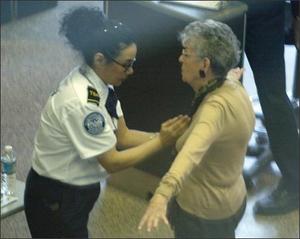Aviation securityLawmakers demand better TSA pat-down training
Lawmakers write the president, TSA to demand a better system of security checks at airports; demand ; “Surely it is possible to secure an airplane without sacrificing individual liberties or privacy. We can utilize bomb-sniffing dogs, AIT machines as a method of secondary screening, and behavioral profiling to accomplish the shared goal of safe and secure air travel,” Rep. Jason Chaffetz (R-Utah) wrote Obama; “These new searches are a novel procedure both for the traveling public and your front line TSA officers, and I am not convinced the Transportation Security officers have received adequate training in what is clearly an invasive procedure,” Senator Olympia Snowe (R-Maine) wrote the TSA administrator

Lawmakers are demanding elevated training standards // Source: prisonplanet.com
In separate letters issued Monday, two U.S. lawmakers are looking for answers on the training and methods employed by Transportation Security Administration (TSA) agents, including one congressman who wants to know why officers trailed a videographer who taped a kid stripped at the security gate.
Representative Jason Chaffetz (R-Utah), who is expected to become chairman of the House oversight subcommittee responsible for the federal workforce, wrote President Obama demanding that he initiate a probe into why TSA officers followed around Luke Tait, a Utah Valley University student who on Friday recorded a young boy having his shirt removed by his father so that agents could confirm he was not carrying any contraband.
Fox News reports that according to an interview Tait gave to the AP, he took the now-viral video of the boy subjected to the skin-baring search at the Salt Lake International Airport because he “realized something crazy was going on.” The boy’s father removed the child’s shirt, apparently in order to prevent the TSA agent from touching the boy, who had been too shy to submit to a pat-down.
While the kid and his father were allowed to go through security, TSA agents came over and questioned Tait about his videotaping the incident and ordered him to delete the video. He refused, but was allowed to go to his gate where, Chaffetz says, TSA agents sat near him and communicated through walkie-talkies until he boarded his flight.
Chaffetz wrote Obama to say the incidents “do not speak well” of TSA’s security measures.
“Surely it is possible to secure an airplane without sacrificing individual liberties or privacy. We can utilize bomb-sniffing dogs, AIT machines as a method of secondary screening, and behavioral profiling to accomplish the shared goal of safe and secure air travel,” Chaffetz wrote, calling for an investigation of all parties involved.
This is the same concern Sen. Olympia Snowe (R-Maine), cited in a letter sent to TSA administrator John Pistole. Snowe said she wants additional information on rules implemented for new airport screening procedures and a list of alternative screening options in order to make sure the procedures “strike a careful balance between protecting individual safety and preserving individual privacy.”
Snowe said she was concerned about the training methods after hearing reports that the pat-down process was being implemented differently across the nation.
“These new searches are a novel procedure both for the traveling public and your front line TSA officers, and I am not convinced the Transportation Security officers have received adequate training in what is clearly an invasive procedure,” she wrote.
She asked Pistole to respond by 13 December.
Addressing the uproar, White House spokesman Robert Gibbs told reporters Monday that of the 34 million people who have been through TSA screening since the new rules went into place, only about 1 percent have gone through the overall, stepped-up procedure.
Gibbs added that anybody under age twelve will go through a modified procedure, according to TSA, but he acknowledged that the new rules have not been implemented in the best way they could have been.
“If somebody feels as if they have been unduly subjected to something that they find to be far more invasive than the line of convenience and security, they should speak to a TSA representative at the airport,” Gibbs said. “TSA is trying desperately to strike that balance. That will evolve … The evolution of the security will be done with the input of those that go through the security.”
In response to the incident at Salt Lake City airport, TSA issued a blog Monday saying that travelers will “not be asked to and you should not remove clothing (other than shoes, coats, and jackets) at a TSA checkpoint. If you’re asked to remove your clothing, you should ask for a supervisor or manager.”
Earlier in the day, Representative John Mica (R-Florida), who is likely to be the next House Transportation Committee chairman, said part of TSA’s problem with the pat-down system is the agency is so large that efforts to implement new rules fall apart.
“They’re now a big personnel agency. They’re trying to manage tens of thousands of people. When they implement things like the pat- down and this new technology, it’s been a disaster. Everybody’s complaining about it. And they never consulted Congress — it wasn’t properly done,” he told Fox News.
